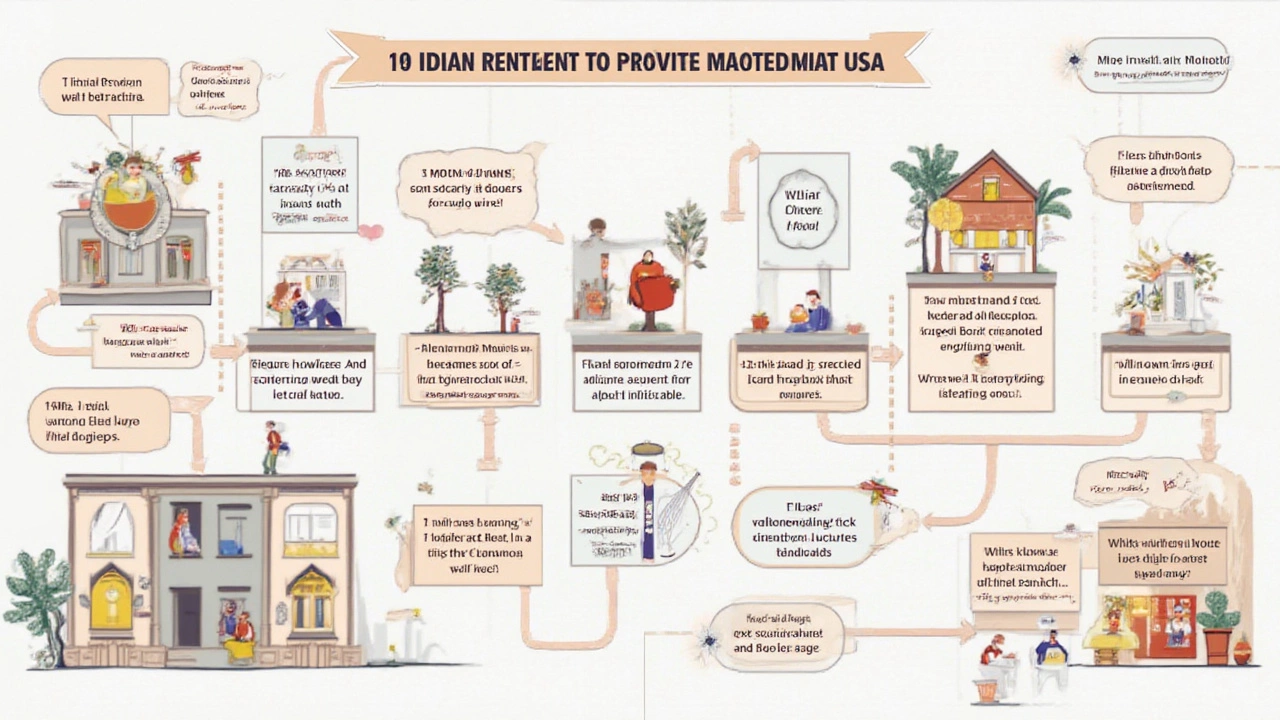How to Rent an Apartment in the USA: Step-by-Step Guide for 2025

Jul, 27 2025
Hunting for an apartment in the USA is a sport all on its own. Renters are constantly in the ring—touring, competing, and sometimes fighting over square footage, location, and rent prices. If you think you can just show up, hand over the first month’s rent, and collect keys, brace yourself. The process has sharper twists than a season of reality TV. Americans move a lot, with the Census Bureau clocking 31 million people relocating every year. The truth? The competition’s tough, and each city brings its own quirks and unspoken rules.
Preparing for Your Apartment Hunt
Before you even start poking through online listings, you need to have your act together. Landlords don’t mess around, and if your paperwork isn’t ready, someone else is going to snag that perfect place while you scramble to find last year’s tax forms. Most landlords want proof that you earn at least two or three times the rent. So if a studio is $1,500 a month, expect to prove $3,000–$4,500 in monthly income. Pay stubs and bank statements are clutch. Don’t have a steady job? Showing freelance contracts, an employment offer letter, or a decent savings balance sometimes works, but expect extra questions.
Your credit score matters more than you think. Anything over 650 is strong, but every landlord picks their own cutoff. If you’re an international renter, you might not have a US credit file yet. In that case, your job offer or a bigger deposit can sometimes help you break through. Savvy landlords will also call your old landlord (or want a reference letter). If you skipped out on rent before, expect trouble. Weed out problems ahead of time—get your former landlord or property manager’s email ready, and ask them for a glowing reference if they’re still speaking to you.
You’ll need some cash upfront—seriously. In big cities like New York, expect to plunk down first month’s rent, a security deposit (usually equal to a month’s rent), and sometimes even a broker’s fee (another month’s rent). That can mean $4,500–$7,000 out the door just for a place that’s a pleasant 400 square feet. Smaller towns might relax this, but it’s better to have more than less.
Before you comb the listings, make a list (yes, an actual list) of what matters to you. Do you want a washer and dryer in-unit? Parking? Pet-friendly? Know what’s a must-have and what’s a nice-to-have. Set a strict budget. And here’s a reality: The more flexible you are on location, amenities, and move-in date, the easier your search.
A quick note: Digital rental scams exploded by over 30% since 2021, according to Apartment List. Never wire money before seeing a place—ever. If it sounds too good to be true, walk away. Try searching on a few reputable sites and apps:
- Zillow
- Realtor.com
- HotPads
- Craigslist (with caution)
- Apartment List
- Facebook Marketplace
Watch for new listings in the mornings—they’ll get snapped up fast, especially in competitive areas.

The Application and Approval Maze
Touring an apartment is like going on a first date. You’re nervous, you’re sizing up the other person (okay, the apartment), and you put your best foot forward. Renting in the US means dealing with a mix of property managers, agents, and mom-and-pop landlords—each with their own style. Sometimes applications are online; sometimes you fill out a surprisingly old-fashioned paper form and hand it in. Here’s what nearly all ask for:
- Government-issued ID (passport, driver’s license, or Green Card)
- Proof of income (pay stubs, offer letter, bank statements)
- Credit report or social security number
- Rental history or reference (previous landlords)
- Application fee (usually $35–$100 for a credit/background check)
Fill everything out clearly, honestly, and quickly. Properties don’t wait. The best tip? If you’re in a tight market, bring a printed “renter’s resume”—a one-pager with your info, references, and details the landlord might ask for. People who look organized tend to get chosen over folks who scramble for documents late at night.
Once landlords review your application, they’ll usually check credit, call references, and sometimes run a background check. If you have blemishes—like a past eviction or late payments—it’s better to explain it up front. Some cities and states restrict landlords from denying you based solely on criminal or eviction history, so check local laws.
If you need a cosigner—someone who legally backs your lease and promises to pay if you don’t—it has to be someone with good credit and a US income. Cosigners can save the day if you’re a student, new to the US, or don’t earn enough alone.
Approval isn’t always instant. While some apartments tell you within 24 hours, others take several days—especially big management companies. If you’re waiting for an answer but finding other great places, don’t be shy: Apply to more than one. There’s no penalty for having several applications out—just budget for the fees.
Let’s talk about signing the lease. Leases are contracts—read them. Seriously. A 2023 National Multifamily Housing Council survey found nearly 62% of renters gloss over lease terms and regret it later. Don’t let that be you. Key things to check: How much notice do you need to give to move out? Can they raise your rent, and how? Are pets allowed? What happens if you break the lease early?
Here’s a quick look at typical upfront costs around the country:
| City | Median Rent (1BR) | Security Deposit | Broker Fee | Total Move-In |
|---|---|---|---|---|
| New York, NY | $3,300 | $3,300 | $3,300 | $9,900 |
| Los Angeles, CA | $2,300 | $2,300 | None standard | $4,600 |
| Dallas, TX | $1,500 | $1,500 | Rare | $3,000 |
| Seattle, WA | $2,000 | $2,000 | None | $4,000 |
Once approved, ask about move-in dates, procedures, and whether you get a walk-through. Video your move-in inspection on your phone, marking any problems. ‘Wear and tear’ disputes are legendary—you don’t want to lose your deposit over some scuffed baseboards you never touched.
“Details in a lease are like fine print on a prescription—ignoring them can cost you not just money, but also your peace of mind," says Dan DiClerico, a home expert at HomeAdvisor.

Secrets to Standing Out and Making the Most of Your New Place
With housing in hot demand, how do you make yourself the kind of renter everyone wants? Keep it simple: Be fast, be nice, and follow through. Get your paperwork in hand before you ever tour a place. Show up on time. Ask good questions—what’s included, how’s the heating, is there maintenance on call? Showing a little genuine interest goes a long way. Landlords often pick the applicant they think will be a good neighbor, pay on time, and not cause headaches.
If you really want a spot, small gestures count. Hand your documents in a folder. Write a quick cover note with your application (“I’m relocating for work, planning to stay long-term, and love the building’s vibe.”). This isn’t about flattery; it’s about reassuring the landlord you aren’t a risk. Sometimes offering a slightly higher deposit helps in competitive markets, especially for pet owners.
Talk money straight. Ask about utilities—are water and heat included, or are you expected to sign up with every provider separately? In older buildings, some landlords control everything, while in new construction, tenants might foot every bill, from trash pickup to snow removal. It adds up fast, and you don’t want surprises halfway through the month with an electric bill bigger than your car payment.
Lock down renters’ insurance. This tiny policy protects your stuff in case of fire, theft, or leaks—and landlords now expect proof before you get keys. Expect to spend $10–$20 a month for decent coverage. According to the Insurance Information Institute, 57% of renters carried insurance as of 2022—a number that’s growing fast.
Don’t be shy with your neighbors. American cities have a weird reputation—sometimes people barely know who lives next door. Making a quick intro can help with everything from borrowing a wrench to finding the best local pizza. You’ll also hear first about apartments opening up, perfect if you want to upgrade or bring in a friend.
If you run into trouble during your lease—repairs that don’t get done, noisy neighbors—don’t stew in silence. Email the landlord, keep a paper trail, and know your rights. Cities like San Francisco, New York, and Los Angeles set strict standards for habitability, but elsewhere you may have fewer protections. It’s worth knowing the phone number for your city’s housing agency, just in case.
When it’s time to move out, clean well and patch minor holes. Take date-stamped photos. Email your landlord your updated address for the deposit return. Legally, most states require landlords to return deposits within 14–30 days, minus documented damages. If they don’t, small claims court can be your best friend.
If you’re willing to stretch your search, try overlooked neighborhoods. You might find places with better amenities, lower noise, and friendlier terms. Sometimes the best apartments never hit big websites—agents and current tenants spread the word first. Showing you’re dependable now means you’ll have an easier time the next time you need to move.
The US rental world changes fast, with remote work, market shifts, and new tenant protection laws. But one thing stays true: Being organized, honest, and a little savvy gets you the keys—and helps you keep them.